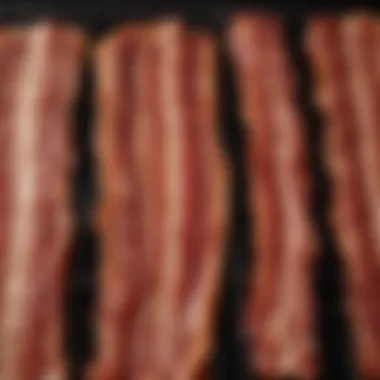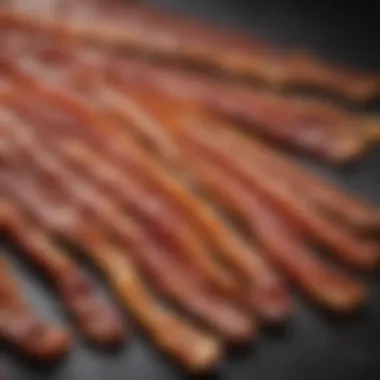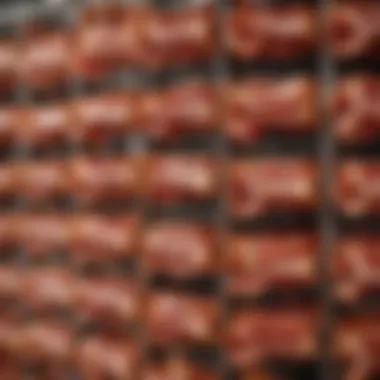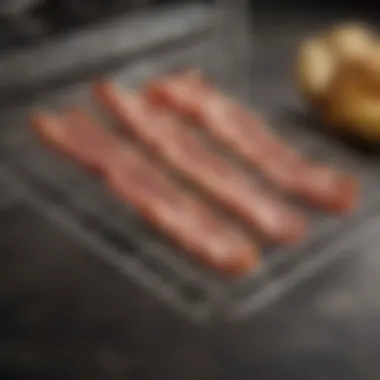The Comprehensive Guide to Bacon Racks for Cooking


Intro
When it comes to cooking bacon, each detail can make a world of difference. Enter the bacon rack, an unsung hero often overshadowed by its more glamorous cohorts like skillets or grills. But let’s not kid ourselves—this tool can be a game changer, affecting not just the flavor but the overall cooking experience.
Getting a grip on what a bacon rack does goes beyond the mere act of cooking crispy strips. It intertwines with health considerations and culinary efficiency. Imagine being able to enjoy that delectable, smoky flavor while reducing splatter or minimizing the greasy aftermath of a bacon binge. A good bacon rack elevates the cooking process, allowing grease to drip away and giving the final product a crispness that’s hard to beat.
As we peel back the layers of bacon racks, we will explore their various types, benefits, and proper upkeep. It might sound a bit dry to some, but trust me, for anyone who relishes a perfectly cooked piece of bacon, this is important stuff. From creating mouth-watering breakfast sandwiches to experimenting with international dishes, integrating a bacon rack into your kitchen toolkit may just open doors you didn’t know existed.
Understanding Bacon Racks
Bacon racks have become increasingly vital in modern kitchens, especially for those who take their culinary adventures seriously. While bacon might seem like a humble ingredient, the way it is cooked can make all the difference between enjoying a delightful crispy strip or a greasy limp piece. Understanding bacon racks is about grasping the nuances of how they work and the tangible advantages they bring to the table.
Definition and Purpose
Simply put, a bacon rack is a specialized cooking tool designed to hold strips of bacon while they cook, typically in an oven. Its purpose is rather straightforward: to elevate the bacon above the grease that drips off during cooking. This small change in cooking method can lead to significant results. By allowing the fat to drip away, the bacon not only cooks more evenly, but it also ends up being less greasy. This results in a crunchier texture that many people appreciate. Furthermore, because the rack positions the bacon in a single layer, it minimizes direct contact, therefore avoiding a steaming effect that often happens in a pan.
Historical Context
Historically, bacon has been a beloved food across various cultures, making its mark from Roman times through to modern-day barbecues. Early methods of cooking bacon included frying it in pans or over open flames, which often resulted in a mess of grease and splatter. It wasn’t until the invention of various cooking appliances that the concept of using a rack took root. In fact, around the mid-20th century, as ovens became more common in households, the bacon rack emerged as a solution to the traditional cooking challenges. It makes sense considering that people wanted to enjoy their bacon without the fuss.
Today, more kitchens have adopted this simple yet effective innovation, pushing bacon's culinary status upwards as people explore new methods in the kitchen.
Differences from Traditional Cooking Methods
Using a bacon rack contrasts sharply with the conventional method of frying bacon in a skillet.
- Grease Reduction: Traditional frying leads to the bacon simmering in its fat, which can enhance flavor but often results in greasiness. The bacon rack allows for fat drippage, making for a cleaner slice.
- Even Cooking: When bacon is laid flat on a rack, the heat circulates around each piece, promoting uniform cooking. This is a prime advantage over the frying method, where bacon may curl or not be exposed evenly to the heat.
- Cleanup: Using a bacon rack greatly simplifies the cleanup process. Instead of scrubbing a greasy frying pan, the mess is contained and can often be resolved with little more than a few wipes.
In summary, bacon racks aren't just a modern fad; they're a thoughtful evolution in the kitchen world that fosters both flavor improvement and efficiency. For food lovers, understanding these racks provides newfound appreciation for one of the most loved breakfast staples.
Types of Bacon Racks
Understanding the variations in bacon racks is crucial for those who truly aim to enhance their cooking experiences. Ranging from material types to design features, different bacon racks offer particular advantages. Exploring the nuances can lead to better outcomes in flavor, efficiency, and even health benefits. Choosing the right rack not only reflects one’s cooking style but also meets unique culinary needs.
Material Variations
Stainless Steel
Stainless steel bacon racks are well-known for their durability. They can withstand high temperatures and do not warp easily, making them a reliable choice for various cooking experiences. The shiny surface holds heat well, leading to even cooking of the bacon strips, ultimately rendering a uniform crunch. However, one downside is that if not properly seasoned or treated, food may sometimes stick, so some care is necessary.
Non-Stick Coatings
Non-stick bacon racks enable easy clean-up and make cooking a tad more forgiving. These racks come with a coating that ensures the bacon slides off with minimal fuss. The key characteristic here is convenience; you won’t have to scrub as hard, which is a bonus for anyone who dislikes kitchen chores. Still, one must tread lightly—as excessive heat can sometimes damage these coatings, leading to potential health concerns.
Silicone Options
Silicone bacon racks provide flexibility that traditional materials can't match. They are heat-resistant and often dishwasher-safe, which makes them easy to maintain. A standout feature is their ability to lay flat and take on the shape of various cooking surfaces, which can be handy. On the flip side, they might not always provide the crispiness that some bacon enthusiasts crave since they can trap moisture more than other options.
Design Features
Multi-Tier Racks
Multi-tier racks are designed for the multitasker who loves efficiency. With multiple levels, these racks allow you to cook more bacon in one go—a true lifesaver during brunches or family gatherings. Their essential characteristic is space-maximization; they enable cooking a lot at once without sacrificing taste. However, one must keep an eye on the cooking times between layers, as bacon on the bottom may have a different cooking requirement compared to the top.
Foldable and Stackable Designs
When it comes to storage, foldable and stackable racks shine. These designs cleverly allow you to save space in crowded kitchens. The main strength here lies in practicality; they can become compact at a moment’s notice. They do have a weakness, though: sometimes, their stability might take a hit when being loaded with heavier items, so ensure they’re placed correctly to avoid mischief in the kitchen.
Specialty Racks for Specific Cooking Techniques
Specialty racks cater to specific cooking methods, like air-frying or broiling. Their tailored designs can provide unique cooking experiences that general racks might not accommodate, enhancing flavor and texture. They shine in versatility and precision. Nevertheless, they may not always be suitable for every kitchen, as some need special care or usage instructions that may deter less experienced cooks.
Benefits of Using a Bacon Rack
Utilizing a bacon rack can notably elevate your cooking experience, transforming the simple act of preparing bacon into an efficient, healthier, and flavor-enhancing practice. This section dives deep into the fundamental benefits that bacon racks offer, combining cooking efficiency with improved health outcomes, as well as significant enhancements in flavor and texture.
Efficiency in Cooking
Cooking bacon can be a messy affair with grease splattering everywhere and uneven curls ruining your perfectly cooked strips. A bacon rack takes this common kitchen challenge and flips it on its head. With these racks, multiple strips can be cooked simultaneously, maximizing the output and minimizing the time spent at the stove.
The design of a typical bacon rack allows grease to drain away during cooking. This feature alone not only speeds up the cooking process but also means more even cooking. When bacon lies flat and sits in grease, it often results in a rubbery texture. Utilizing a rack ensures the bacon gets even exposure to heat, promoting a uniform crispiness without burning the edges.


Healthier Cooking Practices
Health-conscious foodies will appreciate the healthier outcomes that a bacon rack provides. The ability to cook bacon with less grease and more air circulation directly contributes to chunking down on unnecessary calories and fats.
Reducing Grease and Fat
One of the prime merits of using a bacon rack is reducing grease and fat. When bacon cooks on a flat surface, much of its grease can seep back into the strips, making for a greasy end product. However, with a rack, the grease drips away into a designated pan below. This process sheds excess fat from the bacon, making it a leaner option overall.
The standout characteristic here is the health benefit of consuming lower amounts of saturated fats. This aspect isn't just about the bacon itself; generally, it aligns well with a healthier diet, especially for those mindful of heart health. While bacon traditionally has been viewed as a guilty pleasure, incorporating a rack turns it into a more palatable addition to meals, enabling people to enjoy their favorite food without the guilt.
Enhanced Air Circulation
Enhanced air circulation is another remarkable advantage offered by bacon racks. The design elevates the bacon strips, allowing air to flow completely around each slice, which is essential in achieving an ideal cooking temperature consistently. This air movement not only helps in reducing fat but also aids in delineating that crispy texture many seek.
Practically speaking, this means that rather than clammy strips that seem to hover in their grease, you get perfectly golden bacon that defines breakfast perfection. Additionally, less moisture means less risk of spoilage over time, which can be especially valuable for bulk cooking.
Flavor and Texture Enhancement
In the arena of flavor and texture, bacon racks prepare not just any bacon, but truly fantastic bacon. This section discusses how racks not only affect the cooking process but also the flavor outcome.
Crispiness Achieved
Crispiness can be quite the elusive quality when cooking bacon. Many find that traditional frying methods can lead to soft or chewy sections due to uneven cooking. Bacon racks address this head-on. As mentioned earlier, optimal air circulation and grease drainage foster even heating.
Crisp bacon is a beloved staple among culinary enthusiasts, turning regular breakfast into a gourmet treat. The reduction of moisture minimizes any risk of steaming, which can lead to disappointing textures. The distinctive crackle of properly cooked bacon is more pronounced with a rack, satisfying the crunch cravings.
Avoiding Steaming Effect
Finally, avoiding the steaming effect is crucial in the cooking process. When bacon sits flat in a pool of its fat, it can inadvertently steam itself, resulting in soggy strips. Using a rack combats this phenomenon by elevating the strips away from the grease, allowing that mouthwatering crispness to shine through.
By maintaining a dry cooking environment, you ensure that each bite delivers that perfect balance of tenderness and crunch without any unwelcome chewiness caused by moisture. This effect solidifies the bacon rack's position as an essential kitchen tool, particularly for anyone serious about achieving the ultimate bacon experience.
"A bacon rack does not just cook; it transforms. The art of cooking bacon changes completely when precision and care are taken with a simple tool."
How to Use a Bacon Rack Effectively
Using a bacon rack effectively can not only save you time and hassle in the kitchen but also ensure that every slice of bacon is cooked to perfection. A bacon rack helps elevate the bacon, allowing excess grease to drip away, leading to crispier and healthier results. Additionally, it promotes even cooking by allowing hot air to circulate around the bacon slices. This leads to fewer burnt edges and more consistent texture.
To get the most out of your bacon rack, it’s essential to understand how to prepare the bacon, explore different cooking techniques, and follow important timing and temperature guidelines. Let’s dive deeper into these critical elements for maximizing your bacon cooking experience.
Preparing the Bacon
Seasoning Options
When it comes to seasoning, the options are as varied as a cook's imagination. While traditional salt and pepper are tried-and-true choices, you can get creative with your flavors. Consider using ingredients like smoked paprika, maple syrup, or even a touch of cayenne for an extra kick. These seasonings can enhance the natural richness of bacon, blending beautifully with its savory notes.
One key characteristic of these seasoning options is their versatility. Smoky, sweet, or spicy profiles can cater to any palate, making seasoned bacon a fan favorite among versatile cooks. By experimenting, you can discover a unique flavor that complements dishes or stands alone as crispy bites of goodness. However, the downside is that too much seasoning might overpower the flavor of the bacon itself, so a light touch is typically wise.
Thickness Considerations
Thickness of bacon slices is another important factor. Thicker slices tend to yield a chewier texture with a meatier bite, while thinner slices crisp up more quickly and tend to be less greasy. The choice really depends on personal preference as well as the cooking method you are using.
Thick-cut bacon is a popular choice among those who enjoy a robust mouthfeel. Moreover, it holds up well to various cooking techniques, making it ideal for recipes that require longer cooking times. On the flip side, thinner bacon cooks faster, which can be beneficial for quicker meals. But beware, it’s often easier to overcook. The balance between thickness and cooking technique is crucial in achieving the ideal bacon experience.
Cooking Techniques
Oven Baking
Oven baking is one of the most favored methods for cooking bacon because it requires minimal effort. You merely lay the slices on the rack, pop it in the oven, and let the heat do its magic. This technique allows for consistent cooking and ensures an evenly crispy product without the usual splattering of grease that comes from frying.
A noteworthy characteristic of oven baking is that it can handle larger quantities of bacon at once, a boon for those feeding a crowd. It’s also a fantastic way to influence flavors by adding a layer of spices or marinades directly on the bacon before cooking. However, while oven baking usually requires longer cooking times, it also offers the convenience of setting the oven and attending to other tasks in the kitchen.
Grilling Alternatives
Grilling bacon is another excellent method, especially for those who love that smoky outdoor flavor. It’s not just for burgers and hot dogs; bacon can shine on the grill, adding a wonderful char and depth of flavor. The key here is to have a carefully managed heat source to prevent flare-ups from the drippings.
Grilling can often lead to beautifully crisp bacon with an unforgettable smoky finish. Many find this method invigorating, as it brings a different ambiance to cooking. However, one must be cautious; it can be easy to burn bacon on the grill if unattended. Grilling also requires proper techniques to catch drippings and avoid messy situations. Hence, a careful watch is essential.
Timing and Temperature Guidelines


When cooking bacon, timing and temperature are the unsung heroes of the process. For oven baking, a common recommendation is to set the temperature to around 400°F (about 200°C) and allow the strips about 15 to 20 minutes, depending on desired crispiness.
For those opting to grill, maintaining a medium heat is ideal, and cooking time can range from 8 to 12 minutes, turning occasionally. The goal is a strip that's perfectly caramelized, yet not overly charred. Continuing to monitor fries as they cook is vital; a watchful eye can mean the difference between crispy perfection and burnt regret.
Maintenance of Bacon Racks
Taking proper care of your bacon rack is crucial for ensuring its longevity and optimal performance. After all, a well-maintained rack not only enhances your cooking experience but also preserves the unique qualities that contribute to perfectly crispy bacon. Regular maintenance guarantees that your rack holds up to repeated use, preventing wear and tear that could ultimately affect its functionality.
Cleaning Techniques
Hand Washing vs. Dishwasher
When it comes to cleaning a bacon rack, the debate often boils down to two camps: hand washing and using a dishwasher. Hand washing is often seen as the gentler option. It allows for more detailed attention to stubborn areas while using minimal abrasion to avoid damaging any coatings.
On the flip side, dishwashers offer convenience, allowing you to toss your rack in without a second thought. However, high heat and aggressive detergents can sometimes lead to quicker degradation of non-stick surfaces.
Choosing between these two methods largely depends on your level of convenience versus care you wish to dedicate.
Removal of Stubborn Residues
Cleaning is only part of the equation; dealing with stubborn residues is another concern altogether. Grease and bacon bits can cling on tightly if left to dry, making it difficult to remove them later. A method that utilizes a soaking technique can be especially effective. Soaking in warm, soapy water helps to loosen particles, making the cleaning process much easier.
Loose debris can then be removed using a soft brush, ensuring that no damage occurs to the rack's surface. It's not just about cleaning; it's about restoring your cooking tool to its original state.
Long-Term Care
Preventing Corrosion
Corrosion can be a significant concern, especially for racks made of metal. To keep your rack rust-free, make sure to dry it thoroughly after cleaning. Avoid leaving it damp, as moisture can lead to rust formation over time. Applying a thin layer of oil after washing can also help create a barrier against moisture.
Being proactive in caring for your bacon rack means you'll be able to use it for many breakfasts to come.
Storage Recommendations
Where and how you store your bacon rack can also play a role in its longevity. A good rule of thumb is to avoid stacking other heavy items on top of it, which could warp or damage the structure. Consider investing in a simple but effective storage solution, like a dedicated spot in your kitchen cabinet or a hanging option if space allows.
Proper storage extends not just the rack's life, but it can also keep your kitchen organized.
Maintaining a bacon rack goes beyond mere cleaning; it’s about ensuring the rack remains a vital tool in your cooking arsenal, providing consistent results that elevate your culinary creations.
DIY Bacon Rack Ideas
In this section, we dive into the world of DIY bacon racks. Many people may not realize the potential they have in their own kitchens. The beauty of DIY solutions lies not just in the cost-effectiveness but also in the ability to tailor the bacon rack to your specific needs and preferences. Creating your own bacon rack can be a fun and rewarding experience, all while elevating your bacon cooking game.
Repurposing Kitchen Items
Using Cooling Racks
Using cooling racks for bacon cooking is a practical idea that speaks to resourcefulness. These racks, designed typically for cooling baked goods, can serve a dual purpose in the kitchen. One notable characteristic of cooling racks is their elevated design, allowing for proper air circulation around the bacon as it cooks. This feature is what sets them apart from other methods, as they help achieve evenly cooked, crispy bacon without the unwanted sogginess.
However, it's important to recognize the limitations. Some cooling racks are not suitable for high-temperature environments, so checking the material specification is essential. Nonetheless, for those who already own a sturdy cooling rack, the transition to bacon cooking can be seamless and economical.
Adapting Broiling Pans
Adapting broiling pans can offer another clever way to create a bacon rack. Most broiling pans come with a top tray that allows grease to drip away from the meat, which can be extremely useful when working with fatty foods like bacon. The key characteristic of broiling pans is their intended high-heat function. This specialty allows them to capture flavor while removing excess fat during cooking, contributing to healthier bacon preparation.
Nevertheless, they can be bulkier than other options, and not everyone may have the right size for their oven. Still, for those with broiling pans readily available, this method can not only optimize cooking efficiency but also ease cleaning, as most come with non-stick surfaces.
Building Your Own
Materials Required
When building your own bacon rack, understanding the materials required is critical. One can opt for a straightforward approach using items such as metal sheets, wire mesh, or even sturdy wood. Metal is a highly beneficial choice due to its ability to withstand high heat, making it ideal for the oven while ensuring durability over time.
It's crucial to check that any material used is food-safe and can handle cooking temperatures. The unique feature of selecting your materials is the potential for customization. You can design your own rack according to the size of bacon strips you prefer or the oven space that needs filling.
Step-by-Step Instructions
Creating a DIY bacon rack involves a few simple steps that anyone can follow. The step-by-step instructions are invaluable as they guide you through the process, ensuring clarity and success. Firstly, gather your materials—ensure you have the essentials like metal mesh, a frame, fasteners, and perhaps non-stick spray.


Next, cut the metal sheets to your desired size, ensuring they fit comfortably in your oven. Assemble the frame, attaching the mesh securely. Remember, proper setup is key to stability during cooking. Once constructed, you might want to coat the surface with a non-stick spray to prevent the bacon from sticking.
This DIY route has the advantage of personalization, as you can modify dimensions or designs to match your cooking preferences. However, it may require tools or skills some may not find accessible.
"DIY solutions not only save money but also give a sense of accomplishment in maximizing the culinary experience."
By understanding these DIY bacon rack ideas, readers can explore creative and practical ways to elevate their bacon cooking. It's about making use of what's already available while considering customization to meet individual cooking needs.
Economic Considerations
When it comes to bacon cooking, economic factors play a crucial role not just in how much you spend, but also in the overall value that bacon racks bring into the kitchen. Understanding the financial dynamics around bacon racks helps elevate them from mere kitchen gadgets to valuable culinary investments.
Price Range Analysis
Bacon racks come in various price ranges, from budget-friendly options to more premium selections. Typically, you can find prices anywhere from fifteen to a hundred dollars, depending on the material, design, and brand.
- Budget Options: Stainless steel racks can often be found around the lower end of the spectrum. Despite being affordable, they still perform well, making them an attractive choice for casual cooks.
- Mid-Tier Products: In the middle price range, racks with non-stick coatings or specialty designs offer better cooking efficiency and easier cleaning. These can cost between thirty to sixty dollars.
- High-End Solutions: Premium choices may include multifunctional racks made from specialized materials, often tailored for the serious culinary enthusiast. Expect to pay upwards of seventy-five dollars for these options.
Each price tier offers unique benefits and features, but it’s important to consider what you truly need. For instance, if you are an occasional bacon fan, a simple stainless steel rack might suffice. However, dedicated cooks might benefit more from higher quality options that promise better durability and cooking outcomes.
Cost-Effectiveness in Cooking
The cost-effectiveness of utilizing a bacon rack extends beyond the initial purchase price. Using a rack can save money in several ways:
- Less Waste: A bacon rack allows for more bacon to be cooked at once compared to traditional methods, ultimately minimizing the usage of energy and time.
- Healthier Options: Investing in a bacon rack can lead to healthier meals, reducing grease intake. Leaner cooks contribute to cost savings on medical bills down the line due to better overall health.
- Long-Term Savings: Higher quality racks may have a steeper price upfront but typically last longer. This results in a lower cost-per-use over time, making them a sensible choice for the long-haul.
The Bacon Rack in Global Cuisines
Understanding the role of bacon racks extends far beyond just improving your weekend breakfasts. This section digs into how bacon racks fit into different culinary landscapes around the world, showcasing their versatility and the innovative applications that transcends just bacon. By highlighting their use in various global cuisines, we can better appreciate this humble kitchen tool's multifunctional potential.
Culinary Applications Across Cultures
American Breakfast Traditions
The American breakfast is synonymous with crispy, golden-brown bacon, often served alongside fluffy scrambled eggs and buttery toast. The bacon rack has become a staple in many homes across the United States for its role in creating the ultimate breakfast treat. One key characteristic of American breakfast traditions is the emphasis on quick, hearty meals that fuel the day ahead. Using a bacon rack enhances this by allowing multiple strips to cook evenly without sitting in excess grease. This cooking method helps the bacon crisp up nicely while reducing unwanted fat, making it a popular choice for those aiming for a great taste without as much guilt.
This approach also enables home cooks to prepare larger quantities all at once, especially beneficial during busy weekends or family gatherings. The unique feature of a bacon rack here is its ability to handle the heat efficiently, which not only conserves flavor but also streamlines prep time—two major advantages in a bustling kitchen environment.
European Pork Dishes
When you step into many European kitchens, you'll find that pork occupies a central role, particularly in the form of bacon or pancetta. Whether you’re savoring British bacon, Italian guanciale, or Spanish panceta, the bacon rack proves invaluable. The common thread across these European dishes is their strong emphasis on preserving the inherent flavors of the meat, which a bacon rack facilitates effectively.
The unique feature here is how various cooking methods, from roasting to grilling, can be adapted to utilize a bacon rack, enhancing the cooking process. For example, a classic English breakfast benefits immensely as the rack allows bacon to be cooked alongside sausages, keeping everything crisp while allowing fat to drip away. This versatility makes the bacon rack a beneficial asset, offering home cooks an efficient way to prepare distinctive flavors without compromising texture.
Innovative Uses Beyond Bacon
Cooking Other Meats
The bacon rack isn't just for bacon, although it shines in that role. It's a transformative tool when it comes to cooking other meats too. Whether it's chicken wings, turkey bacon, or pork chops, the ability to let excess grease drip away proves beneficial. Cooking other meats via this method ensures that they remain juicy on the inside while achieving that enticing crispy skin on the outside. This, in turn, enhances the overall flavor profile of the dish, creating an appealing contrast between textures.
Moreover, using a bacon rack can significantly streamline meal prep on busy weeknights; simply lay out a few racks in the oven for simultaneous cooking. The beauty of this approach lies in its efficiency—allowing different meats to be prepared at once not only saves time but also minimizes cleanup.
Vegetable Preparations
Don’t write off the bacon rack for veggies either. It serves as an excellent way to roast or crisp up vegetables, such as Brussels sprouts, zucchini, or even sweet potatoes. The pivotal aspect of using a bacon rack for vegetables rests on the roasted flavor it helps develop by promoting even cooking and allowing any moisture to escape. As a result, every bite comes potent with flavor, making healthy eating a tad more enticing.
This innovative use is especially beneficial for those looking to sneak more greens into their diets. By providing a method that can make veggie sides equally savory and crispy, the bacon rack effectively encourages culinary exploration. Plus, minimal oil usage translates to healthier meals without losing that desired crunch.
Using a bacon rack is more than just a method for cooking bacon; it's a gateway to diverse culinary experiences that embrace flavor and efficiency in cooking across global cuisines.
Final Thoughts on Bacon Racks
Bacon racks serve as a pivotal tool in modern kitchens, transforming how we cook this beloved meat. Their role transcends mere convenience; they bring forth a shift in not only flavor but also in health consciousness regarding meal preparations. This section aims to encapsulate the importance of bacon racks, highlighting specific benefits and considerations that make them indispensable in culinary practices.
The Future of Bacon Cooking
As we look to the future, it’s clear that the way we approach bacon cooking is in for an evolution. The integration of technology into kitchen tools is becoming increasingly evident. Smart bacon racks that monitor cooking times and temperatures may soon be found alongside traditional racks. This could open up possibilities where precision meets ease, allowing for consistent results every time.
Additionally, with health trends continuing to dominate, the emphasis on reducing fat and grease will push manufacturers to innovate. Expect racks that promote better air circulation and drainage, enhancing the overall crispness without the guilt. Collaborations between culinary experts and tech developers could lead to exciting advancements that enhance flavor while aligning with modern dietary preferences.
"The journey of bacon cooking is just getting started; expect a delightful fusion of tradition and innovation."
Encouraging Culinary Exploration
Culinary exploration is the heartbeat of cooking. It's where imagination meets flavor, and bacon racks play an essential role in that journey. The versatility of these racks—not just limited to bacon—encourages cooks to experiment with various food items. You might find yourself using it for jerky, certain vegetables, or even different cuts of meat, expanding your culinary repertoire.
Moreover, embracing bacon racks can spark creativity in meal presentations. Think of the endless combinations you can create: bacon-wrapped asparagus, apple slices glazed with bacon drippings, or even the age-old bacon-cheeseburger, all cooked to perfection on a rack.















